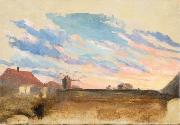La Peinture à l'huile en gros de Chine & Encadre |
|||||||||||

|
|||||||||||
|
|
|
||||||||||||||
|
Amandus Adamson
(12 November 1855, Uuga-Rätsepa, near Paldiski -26 June 1929, Paldiski) was an Estonian sculptor and painter. Born into a seafaring family, Adamson excelled in wood carving as a child. He moved to St. Petersburg in 1875 to study at the Imperial Academy of Arts under Alexander Bock. After graduation he continued to work as a sculptor and teacher in St. Petersburg, with an interruption from 1887 through 1891 to study in Paris and Italy, influenced by the French sculptors Jules Dalou and Jean-Baptiste Carpeaux. Adamson produced his best-known work in 1902. His Russalka Memorial, dedicated to the 177 lost sailors of the Ironclad warship Russalka, features a bronze angel on a slender column. The other work is architectural. His four allegorical bronzes for the Eliseyev department store in St. Petersburg (for architect Gavriil Baranovsky), and the French-style caryatids and finial figures for the Singer House (for architect Pavel Suzor) are major components of the "Russian Art Nouveau" visible along Nevsky Prospekt. |
||||||||||||||
|
|
||||||||||||||
|
||||||||||||||
|
|
||||||||||||||
| Amandus Adamson
(12 November 1855, Uuga-Rätsepa, near Paldiski -26 June 1929, Paldiski) was an Estonian sculptor and painter. Born into a seafaring family, Adamson excelled in wood carving as a child. He moved to St. Petersburg in 1875 to study at the Imperial Academy of Arts under Alexander Bock. After graduation he continued to work as a sculptor and teacher in St. Petersburg, with an interruption from 1887 through 1891 to study in Paris and Italy, influenced by the French sculptors Jules Dalou and Jean-Baptiste Carpeaux. Adamson produced his best-known work in 1902. His Russalka Memorial, dedicated to the 177 lost sailors of the Ironclad warship Russalka, features a bronze angel on a slender column. The other work is architectural. His four allegorical bronzes for the Eliseyev department store in St. Petersburg (for architect Gavriil Baranovsky), and the French-style caryatids and finial figures for the Singer House (for architect Pavel Suzor) are major components of the "Russian Art Nouveau" visible along Nevsky Prospekt. Evening_in_Suur Date 1890s - 1900s Medium Oil on canvas Dimensions 23.2 X 33.5 cm (9.1 X 13.2 in) cyf Date 1890s - 1900s Medium Oil on canvas Dimensions 23.2 X 33.5 cm (9.1 X 13.2 in) cyf |
||||||||||||||
|
Related Paintings to Amandus Adamson :. |
||||||||||||||
|
|
||||||||||||||
|
|
||||||||||||||
|
CONTACTER DES Etats-Unis |







